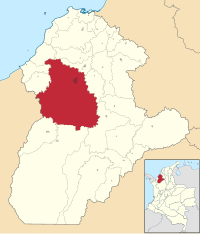Monteria, Colombia
| Montería | |||
|---|---|---|---|

Montería, Colombia
|
|||
|
|||
| Nickname(s): La Venecia Colombiana (The Colombian Venice), La Capital Ganadera de Colombia (The Rancher Capital of Colombia) or La Ciudad de las Golondrinas (The City of the Swallows) | |||
 Location in the Department of Córdoba. |
|||
| Coordinates: 8°45′N 75°53′W / 8.750°N 75.883°WCoordinates: 8°45′N 75°53′W / 8.750°N 75.883°W | |||
| Country | Colombia | ||
| Region | Caribbean Region (Colombia) | ||
| Department | Córdoba* | ||
| Foundation | May 1, 1777 | ||
| Government | |||
| • Mayor | Marcos Daniel Pineda García present | ||
| Area | |||
| • Total | 3,141 km2 (1,213 sq mi) | ||
| Elevation | 18 m (59 ft) | ||
| Population (2015) | |||
| • Total | 454.032 (2,015)(DANE) | ||
| Demonym(s) | Monteriano | ||
| Time zone | Eastern Time Zone (UTC-05) | ||
| Area code(s) | 57 + 4 | ||
| Website | Official website (in Spanish) | ||
| *Monteria metropolitan area is yet to be determined. | |||
Montería is a municipality and city located in northern Colombia and is the capital of the Department of Córdoba. The city is located 50 km (31 mi) away from the Caribbean sea, by the Sinú River. The city and region are famous for their distinct cultural heritages, which include a blend of indigenous Zenú Indians, African descendants, colonial Spanish descendants, and more recently, Arab immigrants. The city is home to the Sombrero Vueltiao, a national symbol; and is the home of Porro folklore music. The city has an inland seaport connected to the Caribbean Sea by the Sinú River.
The area was first settled by Zenú Indians, who lived in the banks of the Sinú River (Finzenú), San Jorge River (Panzenú) and Nechí River (Zenúfana), where the Department of Córdoba is located today. In 2003, dentist and historian Jaime Castro released Historia Extensa de Montería, a book on the history of the city. According to Castro's book, Montería was founded on May 1, 1777 by Spanish officer Antonio de la Torre y Miranda, being governor of the Province of Cartagena officer Juan de Torrezar Díaz Pimienta. The city, which had been named Montería by its inhabitants and located on the east side of the Sinú river, was then renamed "San Jerónimo de Buenavista" and moved to the west side of the Sinú.
San Jerónimo de Buenavista was the name chosen by Antonio de la Torre y Miranda, in order to honor Saint Jeronimo, but people referred to it as Montería. In 1803, the city was burned by a group of natives, so the residents decided to move back to the Sinú's east bank, where it remains today. In recent years, Monteria has seen a growth in population on the west side. In 1923, it became a municipality of Bolívar Department, and in 1952, it was designated as capital of the new Department of Córdoba. Montería was located within the boundaries of the Colombian Department of Bolívar until 1952 when it separated from Bolívar and became the capital of the new Department of Córdoba.
...
Wikipedia


